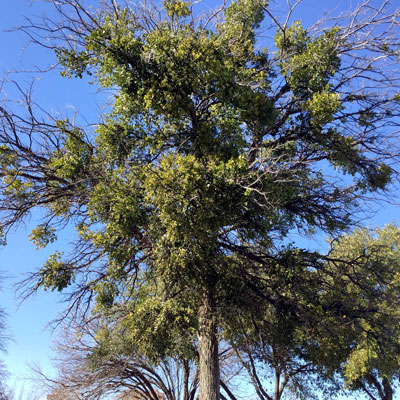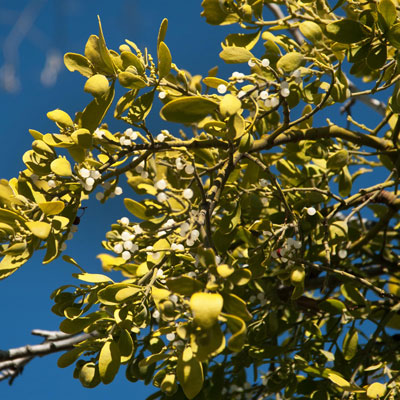Mistletoe Not All That Romantic
Mistletoe is a parasitic plant. It’s like ticks on a dog. It gains its sustenance from the host, and there’s no way you can say that that’s a good thing.

Photo: Cedar elms are the species most commonly attacked by parasitic mistletoe, as evidenced by this tree in McKinney.
What trees are most commonly impacted?
Many types of trees may show up wearing mistletoe for the Christmas Ball, but most common among them are cedar elms, hackberries, bois d’arcs, pecans and red oaks. Among those, cedar elms and hackberries make up the vast majority of the invasions.

Photo: Mistletoe fruit (poisonous to humans) are very attractive to birds. But they’re sticky and they get stuck on the birds’ beaks.
How does it get started?
Mistletoe seeds are attractive to birds. Birds dine on them, then fly to small branches to wipe their beaks clean. Seeds stick to the twigs and start to grow. As the small mistletoe clumps begin to develop, the twigs also get larger. By the time a mistletoe plant is at full mature size (2 feet across), the twig may have grown to be 1 to 2 inches or larger in diameter.
Is there a spray that will kill mistletoe?
Not without doing serious damage to the host tree. After all, by the time the mistletoe plant is large enough to spray, it has essentially grafted itself into the conducting tissues of the tree. It should be noted that certified arborists do have access to a spray (Florel) that will kill much of the growth of mistletoe back to the branches, but it won’t eliminate it completely.
(Keep reading for your best control options.)
What other alternatives do you have?
By far your best means of eliminating mistletoe is to prune out infestations as they are beginning. This is the time of year that they become noticeable.
Use a pole pruner to reach high into trees to clip off the small twigs that are hosts to the young, developing clumps. Do so each year so that you won’t have to use a saw to cut larger branches that are infested with mature clumps.
If the outbreaks of mistletoe are higher than you can reach, hire an arborist to climb into the tree for you. Be very cautious using pruning tools if you have overhead power lines anywhere in your landscape.
